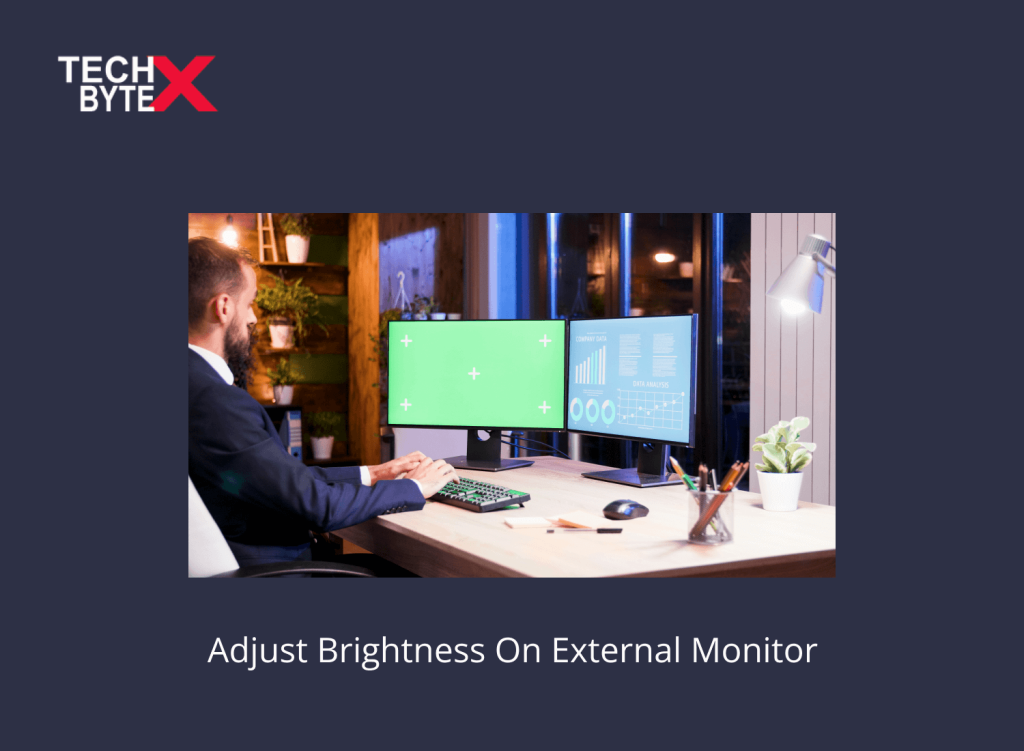The screen’s brightness not only drains your system’s power but also negatively impacts your eyes. However, when it comes to Windows 10, whether on a laptop or computer, display management is not an intricate process. In this article, we will focus on conveying the three best approaches to adjusting brightness on an external monitor in Windows 10. It is important to note that brightness management is a straightforward process in Windows 10. However, when connecting an external display unit, brightness management becomes tricky because Windows does not natively support it.
Let’s explore the three best approaches in the guide below to address how to adjust brightness in Windows 10 on an external monitor.
The Harmful Effects of High Screen Brightness
Many times, we experience shoulder and neck strain, along with tired and itchy eyes. These are the consequential symptoms of spending long hours screening on a smartphone, laptop, or computer. Digital technology is like a dominion, hijacking our lives and causing physical and mental stress. It is making our life easier on the disposal of adverse effects on our health, especially our eyes. Now, when life is handicapped by digital innovations, what we can do is:
- Limit screen time
- Prefer using dark mode or adjusting screen brightness
Only by taking these precautionary measures, you can lessen eye damage and take care of your eye’s well-being. Computer vision syndrome can affect your eye health in the following ways:
- Retinal Damage
- Dry Eyes
- Headaches and Migraines
- Light sensitivity
- Blurred vision
- Itchy or watery eyes
- Eye strain
Discover 3 Effective Approaches to Adjust Brightness on External Monitor in Windows 10
The regular way to adjust brightness in Win 10 does not work when you have to connect to an external monitor or multiple monitors. That’s why, to control brightness, you need to find some relevant, effective, and convenient ways on Windows 10.
Let’s take a look at three methods to modify brightness in Windows when you have a multi-monitor setup.
1. By Using the Monitor Buttons
This method will not work if your monitor’s buttons are not in a functional state. If this is your case, skip it and switch to the next method. The next aspect to be considered is to read the instruction manual of the connected displaying unit or multiple units. The reading hassle does not waste your time; rather, it will save time by knowing your device. Different monitors have different accessible tools for customization that eventually help you to control brightness.
Here is how to adjust brightness on Windows 10 using the monitor buttons:
Step 1: Look for sun-shaped (increase brightness) and moon-shaped (decreased brightness) icons on the bottom or side edges of your monitor
Step 2: Once found, press these buttons to launch the monitor’s OSD menu and access the settings menu. Some monitors are equipped with a tiny joystick or D-pad to navigate the menu
Step 3: Once the settings menu is launched, using the monitor’s controls, navigate to Brightness, Luminosity, Backlight, or similar options available
Step 4: Once the Brightness adjustment option is located in the monitor’s OSD, set the brightness level, ensuring your convenience
Step 5: Once set, confirm the new brightness level by pressing OK/Apply on the monitor
Step 6: This process will change the brightness level on the connected external display units right away
Step 7: After completing the brightness adjustment process for the external monitor, close the OSD menu
This is an effective and convenient way to modify brightness on an external monitor in Windows 10. Most monitors close automatically once the changes are implemented. You can also apply the same method for smart TVs and projectors to control and set brightness on smart TVs, projectors, ensuring comfort.
Why you should use monitor controls to adjust the brightness?
Here are some perks of using monitor controls to adjust brightness for an externally connected display in Windows 10:
- Works even after the monitor is disconnected from external dismay units
- Offers smooth and effortless control to modify the brightness scale
- No additional software required
- This is a quick process
- No intricacy involved
- Any person with average knowledge can do it
2. By Using the Night Light Feature
Change brightness Win 10 by utilizing the Night Light feature, a practical option. If you are eager to activate the Project mode to set at “Second Screen only”, it will be the best route to implement it.
Here’s how to adjust Windows 10 brightness using the Night Light feature for an externally connected display:
Step 1: Right-click on your desktop
Step 2: Select ‘Display Settings’
Step 3: Go to the “Multiple Displays”
Step 4: Set the Projection mode to ‘Second Screen Only’
Step 5: This process will turn off your laptop’s screen by extending your desktop to the external monitor
Step 6: Now, launch the Settings app
Step 7: Navigate to > System > Display > Night Light Settings
Step 8: Toggle on the ‘Turn On Now’ option
Step 9: This will make your external monitor lit with a yellow flash
Step 10: Drag down the slider to adjust the Night Light intensity at your comfort level
Step 11: When done, you can toggle off the Night Light, or for safety concerns you can also keep it as an anti-eye strain precaution
Why you should use the Night Light feature to control the brightness level on the external monitor in Windows 10?
Here is why you should choose this trick to modify brightness:
- Perfectly functions even if your external display has nonfunctional brightness controls
- An easy solution to indirectly modify brightness level
- Offers a soothing, warm, and a bit dusky effect, ensuring eye relief
- A handy workaround that is accessible via Windows itself
3. By Using Third-Party Apps
If you are not satisfied with the previous two approaches, don’t worry; take better control over your externally connected display via third-party solutions. They offer quick, handy, and reliable brightness control for your external monitor in Windows 10.
What are the Best Multi-Monitor Brightness Control Third-Party Apps for Windows 10?
Here are some of the best screen brightness controllers available that you must consider and try:
- Twinkle Tray Brightness Slider
- Monitorian
- Dimmer
- CareUEyes
- Iris
- Windows10 BrightnessSlider
Here’s how to change the brightness of the external monitor in Windows 10:
You can pick any third-party app for satisfactory brightness control. For convenience, we are using Monitorian to control external display brightness.
Step 1: Install and launch the Monitorian app from the official website
Step 2: Monitorian is equipped with a clean user-friendly interface; launch it to proceed
Step 3: This will display your connected displays, along with respective model names
Step 4: Select and click on which you want to set the brightness level
Step 5: Set the intensity by dragging up or down the slider
Step 6: Ensure that Monitorian keeps on running in the background; otherwise, it will disrupt brightness modifications in the externally connected displays
Why you should use third-party apps to adjust the brightness on an external monitor in Windows 10?
Here are some key benefits of using a third-party app to adjust the brightness level in Windows 10 for the external monitor:
(These are the general benefits of screen brightness controllers, not referring to Monitorian)
- Provide seamless brightness adjustment options
- Allow users to synchronize brightness across monitors at a time
- Equipped with advanced settings like screen dimming, keyboard shortcuts, and more
- Capable of retaining brightness settings for that display even after being disconnected
Frequently Asked Questions
Here are some common user queries about modifying brightness on their external displays in Windows 10. Adjusting the brightness is crucial for a comfortable viewing experience. Let’s take a look below to address users’ concerns regarding the said topic:
Why is my external monitor brightness control not working in Windows?
Here are some important checks you need to do to fix it:
- Toggle on the monitor button to switch inputs
- Check the brightness slider in Windows display settings
- Reconnect the display cable
- Update your GPU drivers
Hopefully, this can help.
How do I disable automatic brightness adjustment in Windows 10 to affect external monitor brightness?
- Go to System > Display settings
- Turn off the Change brightness monitor that automatically controls the screen light
Can I set separate brightness settings for my laptop screen and external monitor at the same time?
Certainly, Windows 10 allows users to configure the brightness intensity of each display unit independently using the brightness sliders present in the display settings.
Will closing my laptop lid turn off the external monitor connected via Windows 10?
No, it does not happen, you can switch off your laptop. This will not turn off your external display; it will remain powered on.
Why does my external monitor flash with a yellow tint; is it normal?
Yes, it is absolutely normal. It happens when you lower the brightness level, and sometimes it adds a yellowish hue on some monitor screens. You can correct it by adjusting the RGB color settings on the monitor.
Can I modify the brightness of my external monitor using my keyboard?
Certainly, if you are interested in changing the brightness on the second monitor via the keyboard, the good news is that it is surely practical. Use the F1-F2-Fn keys to increase or decrease the brightness intensity.
What if I set the monitor brightness to 100%?
Setting the brightness to 100 % is not safe for your eyes; it can cause eye strain and, in severe cases, can also cause eye damage. The safe and optimal brightness level lies between 50-80% during the day and lower after dusk.
Final Words
This article can serve as an awareness resource to inform people about the hazardous effects of screen brightness. At TECHBYTEX, we provide three effective approaches to modify the screen brightness of an externally connected display in Windows 10. The practical approaches include using monitor controls, utilizing the Night Light feature, or employing a third-party app.
It is crucial to change monitor brightness, especially when your screen time is prolonged. Optimal screen brightness intensity keeps your eyes relaxed and enhances your overall work experience.







